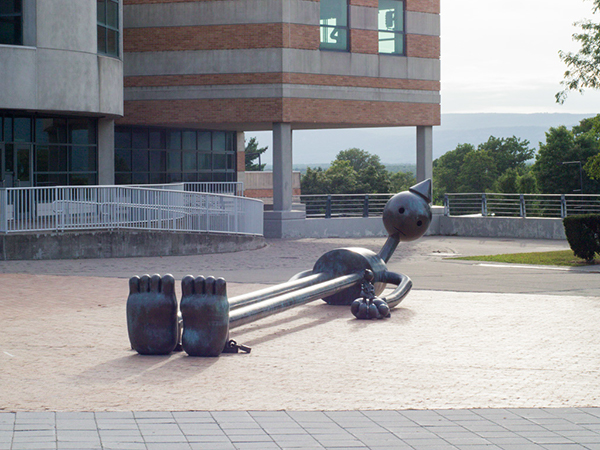

Last May, the New Paltz campus appeared a little smaller, as students hurrying to class were in awe of the sleeping giant who seemed to have appeared overnight.
His name is “Gulliver.”
The massive, whimsical sculpture, named and inspired from the Jonathan Swift’s tales of “Gulliver’s Travels,” rests chained upon the Fine Arts Building Plaza. Spanning 36 ft. and weighing 3,500 lbs., this bronze sculpture was created by world-renowned artist Tom Otterness.
Daniel Belasco, the Dorsky Museum’s curator of exhibitions and programs, was in the process of curating the current exhibition “Dick Polich: Transforming Metal into Art” when the idea to bring “Gulliver” to SUNY New Paltz came to fruition.
Belasco wanted Polich, famous for creating very large-scale works of public art, to be truly embodied in the exhibition – for those who experienced the exhibit to get a full sense of what Dick Polich had accomplished in creating huge works of art while illustrating skill and beautiful craftsmanship.
Otterness, who also has various other smaller pieces currently in the exhibit, mentioned to Belasco that “Gulliver,” who had just spent time on the campus of Western Michigan University, was to return to Otterness’s Brooklyn studio and would be able to make a stop on his way home.
“It was a great opportunity,” Belasco said. “Otterness is a perfect artist for a university campus because he’s approachable, very engaging, charming and humorous-, but also has a literary connection and a satirical quality to [his] work.”
Belasco said this wasn’t simply a Dorsky initiative, but a university loan approved by the college’s Arts and Aesthetics Committee in conjunction with the museum, approved by all involved in support of having an “engaging campus full of art of all sorts.”
The creation of “Gulliver” is as animated and eccentric as one can imagine. The statue was initially made for a fairytale-themed park in the Netherlands.
“It has an ‘Alice in Wonderland’ feel,” Otterness said. “The shift of scale from small to large – small figures around large figures.”
Over the summer, a sign was placed in front of “Gulliver” that declared it “under surveillance.” Belasco said this was to deter skateboarders from utilizing “Gulliver” for their recreational needs. It was removed at the start of the fall semester to return the statue to its intended aesthetic, as the artist envisioned.
“I hope people sit on it, use it to socialize,” he said. “I hope they are amused by it and understand the story, of these little people having this key and deciding whether to let him out or not.”
Indeed, “Gulliver” is topic of conversation.
“To have the work of an internationally-recognized artist here is a big deal,” said associate professor of sculpture Emily Puthoff, who uses the piece, as well as Otterness’ other pieces in the exhibit, as an example during her Sculpture Casting & Moldmaking class.
Belasco has heard talk of varying interpretations from students as to what “Gulliver” is meant to represent. With the sculpture appearing around finals week last semester, many seemed to identify with “Gulliver” as he layed there, chained to a college campus. Some who were graduating felt as though they were “Gulliver” about to break free. Others believed it was a tangible representation of the one percent’s grasp on the 99 percent.
And in these varying views is where the greatness of the work comes from — the artist has his own particular idea, Belasco said, but it doesn’t mean that anyone else’s idea isn’t valid.
“I really like the sculpture and I think it’s awesome the school brings in outside work from other artists,” fourth-year visual art education major Sarah Platt said. “It’s neat to see a large-scale sculpture in the middle of campus, even if it’s for a short time.”
Belasco said at the end of this semester, the future of “Gulliver” is uncertain.
“I just know Otterness doesn’t want him back in the studio,” Belasco said. “He wants ‘Gulliver’ to be out in the world.”
